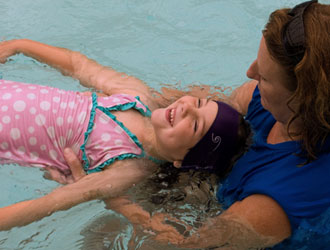Floating and Balance
 There are five basic steps in teaching someone how to swim and it is important that none of these steps are skipped however before a pupil can venture into some formal skill development they need to learn how to balance in the water. This may sound like a strange statement until you take into account how different being in the water is to being on the land. When a child/adult gets into a large body of water for the first time the gravitational forces acting on their bodies are severely reduced. Even the most basic skills; like standing, sitting and walking; we can perform on land, can cause a child/adult to panic as they feel like they have no control over how their body is behaving. Every aspect of being able to swim, from the elite level to the beginner, revolvs around balance and how well you can control your breathing. Once you have mastered your breath control and adjust to the feeling of being weightless then the real formal skill development can start.
There are five basic steps in teaching someone how to swim and it is important that none of these steps are skipped however before a pupil can venture into some formal skill development they need to learn how to balance in the water. This may sound like a strange statement until you take into account how different being in the water is to being on the land. When a child/adult gets into a large body of water for the first time the gravitational forces acting on their bodies are severely reduced. Even the most basic skills; like standing, sitting and walking; we can perform on land, can cause a child/adult to panic as they feel like they have no control over how their body is behaving. Every aspect of being able to swim, from the elite level to the beginner, revolvs around balance and how well you can control your breathing. Once you have mastered your breath control and adjust to the feeling of being weightless then the real formal skill development can start.
The first of the major hurdles for a pupil, in the Learn to Swim process, is to trust the water to hold them up. A common term for this stage in the Learn to Swim process is Floating. Some pupil’s find it very difficult to lie face down in the water and trust the water to support their body weight. In fact some pupils seem to take forever to get this confidence. The fear is not just related to trusting the water to hold them up but is a combination of things. Older pupils can be frightened that once they lie on top of the water they will not be able to get back on to their feet, and as soon as they are taught the technique of getting back on to their feet, this fear goes away.
There are no shortcuts to getting a pupil to float on top of the water; it is a matter of trust and perseverance. First the pupil needs to trust the instructor and then they need to feel how the water supports their body weight when they take their feet off the bottom. Floating is a balancing act. As the pupil struggles to get their balance on top of the water they need lots of encouragement.
It can be a very scary stage and the pupil needs a lot of support from parents and the instructor as they struggle with this very important skill development.
Once the pupil can float, then learning how to kick and work their arms are relatively easy steps. Learning how to float is probably the most important step in the learning process and is not one that can be neglected or rushed. Once a pupil can float in the water their confidence level rises rapidly. Floating is a basic survival technique. Of course once the pupil learns to float on their face it is a relatively easy matter to get them to float on their back. Being able to float on their back also brings added confidence.
Over the years I have taught pupils who have learned to swim at other swim schools, but could not float. The floating stage was skipped because the teaching technique some swim schools use involves lots of aids, kick boards, noodles, too much support from a teacher and not enough focus on the core skill development. As a result these pupil were scared to swim across the deeper water because they thought that if they stopped swimming they would sink. Once I taught them to float and refined their balance by focusing on their head position and unnecessary head movement, there were no more worries about swimming in the deep end.
If your child is struggling with mastering the floating stage of the process then give them plenty of encouragement and point out to them that the water is very strong and holds up big ships so it will surely hold up tiny little things like children. Keep reinforcing what the instructor is saying about the water holding them up. Above all, be patient while your child learns to float.
Chris Shapland
« Previous article Next article »
Booking request
Testimonials
Amazing review from Mandy
I would like to put in writing my appreciation for administrative and swim instructor team at Warner...
6 years of fabulous swimming lessons
After 6 years of fabulous swimming lessons with you without a single break, thanks for all that you have...
Just started and very impressed
Ted started with you 3 weeks ago and i just wanted to say I am beyond impressed with your school and in...


